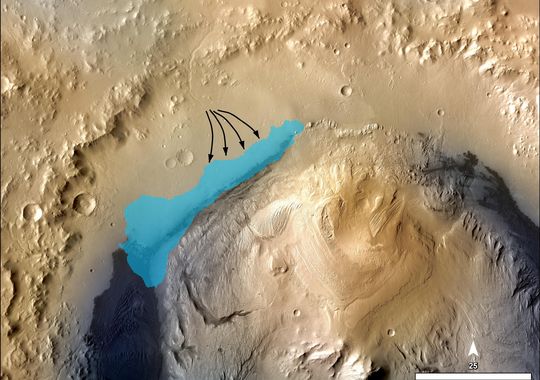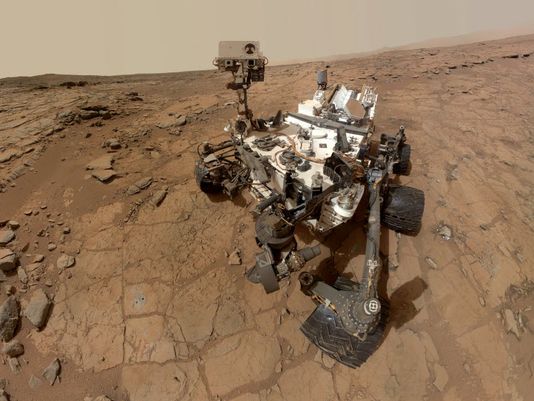Mars crater may have supported microbial life forms
NASA's robotic rover on Mars has found signs that a vast and hospitable lake once spread over the now-desolate Martian surface, providing a potential home to past life for centuries or longer.
The shallow water body was roughly the size of one of New York's Finger Lakes, though not nearly so deep. Its waters boasted low salinity, just the right acidity and all the chemicals needed to support living organisms. Other than on Earth, the lake was the most life-friendly place in the solar system, according to a study published in the journal Science and announced Monday at American Geophysical Union conference in San Francisco.
"Is this the smoking gun that says there was life on Mars? No," says NASA soil mineralogist Douglas Ming, who took part in the new research. "Is this a smoking gun that this was a habitable environment? There's pretty good evidence for that. We have an environment that is very much … like on Earth."
Despite the difficulties of finding evidence of past life on Mars, "I've always been an optimist that we will find it someday," says astrobiologist Clark Johnson of the University of Wisconsin-Madison, who was not involved with the study. "This is a wonderful step forward."
After its triumphant arrival on the Red Planet in August 2012, Curiosity trundled only a quarter-mile from its landing spot to a tantalizing depression named Yellowknife Bay. There it didn't take long for the rover's instruments to reveal an expanse of thick, fine-grained rock, the footprint of an ancient lake. Tests showed the rock, a type known as a mudstone because it's formed from mud, is similar to 10-million-year-old rocks in Southern California. This single lake probably covered tens of thousands of acres, and there were probably at least several other lakes nearby, says Caltech's John Grotzinger, project scientist for Curiosity.
Veins of mineral in the rocks show that even after the lake dried out, water still flowed across the site. That extra water could have allowed life to persist at the site long after the lake's disappearance, perhaps for tens of millions of years, according to the study in the current issue of Science. Adding to the appeal of this watery real estate, a rock sample collected by Curiosity and analyzed in the rover's on-board laboratories showed a wide array of chemicals needed for life: carbon, hydrogen, oxygen and others.
What Curiosity didn't find beyond a doubt were hydrocarbons, carbon-containing molecules that can serve as an energy source for life and a potential signature of life. The rover did detect hydrocarbons, but at least some of them came from solvents that leaked out of a storage container on the rover itself. The scientists think the hydrocarbon levels measured by Curiosity are too high to be accounted for just by the solvents, but they readily acknowledge they haven't closed the case.
"Most of us feel there is a good chance that there's something there," Grotzinger says. "It's just that we haven't been able to tease it out at the level of confidence we'd like."

This illustration released Monday by NASA depicts a concept for the possible extent of an ancient lake inside Gale Crater.(Photo: NASA/AFP/Getty Images)
Grotzinger and his team argue that even without hydrocarbons, the lake could've supported life, though not the little green men of popular imagination. The obvious candidates are bacteria and other microscopic creatures that make their living off chemicals rather than sunlight. Such microbes are found at Earthly hot springs on both land and the ocean floor, some living under extreme conditions that would be lethal for many other forms of life.
Other scientists find most of the new results generally convincing, though they are skeptical that Curiosity has found hydrocarbons.
The scientists' arguments that the rover found more hydrocarbons than would be expected from contamination alone are "tenuous at best," says Jeffrey Bada, an emeritus professor of marine chemistry at the Scripps Institution of Oceanography, via e-mail. He says that if Curiosity really had stumbled on hydrocarbons, other kinds would've been detected, not just the few purified by the rover's chemistry set.
Others point out that living things have colonized much harsher environments on Earth than this gentle Martian lake, making it possible that microbes once called it home.
"If you give it an environment, life is going to spontaneously develop, so why not?" Johnson says. "But it's not proven, and people should realize that to actually prove it … is probably many years down the road."










